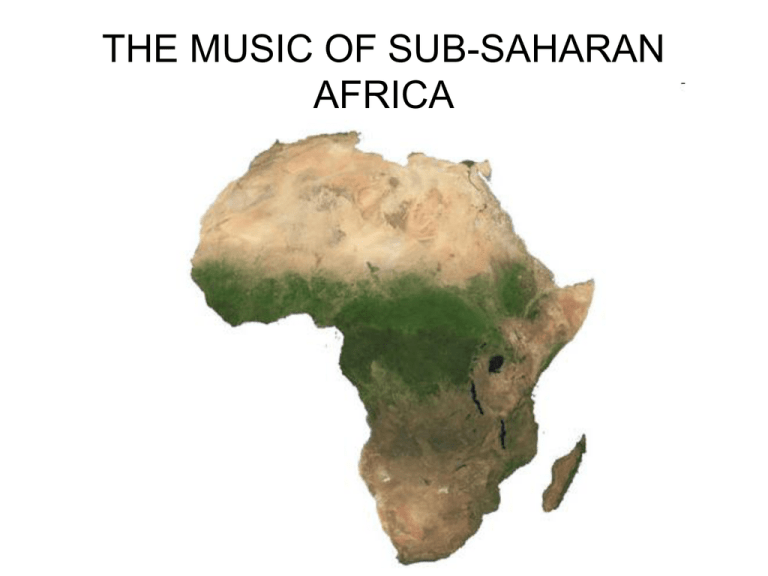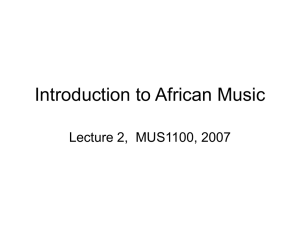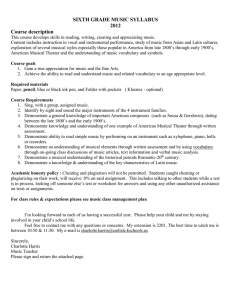Africa
advertisement

THE MUSIC OF SUB-SAHARAN AFRICA Sub-Saharan Africa is extremely diverse We will explore the relationship between African music and the kinds of culture that produce it A Shona Mbira performance in Zimbabwe is our first case study Mbira music: "Nhemamusasa" Textbook CD 2, track 11 The Pygmies are nomadic hunters and gathers of equatorial Africa They use vocal choirs, flute duets, trumpets made from tree bark or ivory, and the musical bow BaMbuti vocal music: “Alima Girls’ Initiation Music.” Textbook CD 2, track 12 The Mande of West Africa come from Senegal and Gambia Kora music: “Ala l’a ke” Textbook CD 2, track 13 The Ewe of Ghana have club organizations that maintain semiprofessional drum and dance troupes “Gadzo” Textbook CD 2, track 14 The Buganda Kingdom desecrated musical instruments after the 1962 insurrection Greetings and Praises Performed on the Yoruba Dùndún Drum Textbook CD 2, track 15 Musical Bow Played by a BaMbuti Pygmy Textbook CD 2, track 16 Popular music in the twentieth century includes West African highlife brass bands I.K. Dairo and The Blue Spots, “Salome” Textbook CD, track 17 “Chitima Ndikature” Thomas Mapfumo and The Blacks Unlimited Textbook CD 2, track 18 Despite the diversity, a few underlying principles characterize the music of the whole region Interlocking is the practice of fitting pitches into spaces between other parts An example is the whole melody created by a mbira player’s two hands Call and response is very common Hocket is the interlocking pitches between two or more sources. An example is Pygmy vocal music Dense, overlapping textures and fuzzy timbres in overlapping drum rhythms is common Ostinatos are the basic foundation of a performance Community participation is key The importance of rhythmic complexity is not to be underestimated Summary Sub-Saharan Africa is a huge area. There are, however, some common general musical characteristics African music favors ostinatos, polyphony, and interlocking parts Musical performance is often a communal participatory activity Many musical performances accompany religious or civic rituals Social structure and conditions influences music and performance Key instruments include lamellaphones (the mbira), strings (the kora), xylophones, trumpets, flutes, musical bows, and drums During the 20th century, cosmopolitan musical influences have been incorporated into the African musical scene Is there an equivalent to African interlocking in Western music, and how might it work? Is there an equivalent to African interlocking in an Asian music studied thus far, and how does it work? Why would Pygmy communal living bear an influence on vocal hocket? Why would Pygmy nomadic life prevent Pygmies from using many musical instruments? Why do the words of the jali have as much importance as writing? Are there equivalents to the jali in Western music, and what do they say? Does our popular music use drumming in the same manner as African drumming, or is it different? What might befall an African court music tradition in the event of political insurrection, and how could it be guarded? How have traditional African musical instruments and styles survived in the rapidly changing world?






